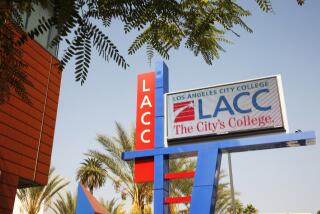People, Not Money, Make the Difference
- Share via
When America’s top research universities glance down at their well-heeled corporate sponsors from their ivory towers, alluring visions of dollar bills just aching to be seduced keep dancing in their heads.
But what do America’s top research companies see when they peer into the groves of academe?
Their view is equally unflattering. They see “many university officials (who) tend to have an inflated view of the importance of university research efforts in innovation,” according to the just-published “Industrial Perspectives on Innovation and Interactions With Universities.”
What’s more, asserts this government-university-industry research round table survey, “many university officials erroneously believe that the discovery of new ideas represents the most significant step in the process of innovation, and that universities are the key source.”
Not so, the report concludes. “Industry is the primary source for innovation. Universities play only a limited role in this realm.”
So much for getting that endowment for the new chair in molecular biology.
Actually, the report--which summarizes the opinions of 17 top research officials from companies ranging from Procter & Gamble to General Motors to Bechtel to Martin Marietta--offers more than the casual snipes at academic pretension. This is what you read if you want quick insight into the conventional research and development wisdoms. It’s a terrific snapshot of attitudes. Sure, most of the comments seem obvious--incremental innovation in industry is more common than breakthrough innovation; the primary role of the university is as educator and provider of talent, etc.--but then, if they weren’t obvious, they wouldn’t be conventional wisdoms.
The overarching message is that these senior officials are less than thrilled with their relationships with and investments in America’s research universities. They’re not getting the bang for the buck that they want. They complain that, while research universities may be loaded with talent and data, they just are not in sync with either the needs or the aspirations of American business. Essentially, universities neither understand nor effectively contribute to the technology transfer process.
This may or may not be true--but that’s what they say, and it should be taken seriously. What also has to be taken seriously, however, is the dangerously narrow perspective that most industries have of the innovation process. To wit, the report notes that “most industry officials interviewed believed that, whereas universities are at the forefront of scientific discovery, product- and process-oriented technical change occurs within industrial firms for most fields.”
This is one of those statements that sounds perfectly reasonable but is actually meaningless. As any sophisticated industrial researcher will tell you, the lines between “scientific discovery” and technical innovation have blurred into shades of gray. Where do you draw the line between the science of molecular biology and the technology of genetic engineering when the same researchers are doing both?
The science of computational chemistry is transforming the technology of new materials design. Mathematical research in digital signal processing is quickly translated into custom-designed computer chips. In virtually every major industry--automotive, aerospace, agriculture, medicine--science and technology are converging.
So here are industry and academe struggling to draw clean research distinctions between themselves at the very time when that’s becoming virtually impossible. The reality is that universities can no longer be seen as traditional “suppliers” of students and “subcontractors” generating new knowledge. A different relationship is necessary, one that’s far more intimate and collaborative than giving a university a million bucks and expensive equipment in exchange for the exclusive rights to some anticipated “breakthrough.”
Proof of this can be found in the single-most interesting finding in the survey. These corporate giants are now turned off by research consortia and expensive alliances. Instead, they’ve discovered that the most fruitful industrial-academic collaborations emerge from the “bottom up”--small groups of researchers from industry and academe who share common interests and build on them.
These people are the people honing the cutting edge of research and innovation--not their bosses. In fact, it is precisely because the research bosses are constantly trying to draw a corporate dotted line between basic science and applied technology that they can’t quite see the convergences their researchers are creating.
Ironically, while the research executives complain about their relationships with American universities, Japanese companies have platoons of their top young scientists and engineers studying at the MITs, Caltechs, Stanfords and Carnegie-Mellons. They prefer to send people, not money. The Americans do just the opposite.
Indeed, the most damning aspect of this survey is that none of the research executives talk about how many people they have on campus or, for that matter, how many top-notch professors and grad students come into their facilities to consult. I’m sure it’s going on--but why wasn’t it discussed?
Institutions don’t collaborate; people do. That’s not a profound statement. However, until both industry and academe recognize that the key to effective university-industry productivity is to enable individuals to collaborate instead of having institutions sign intellectual property deals, the relationships will continue to disappoint. More important, American companies will not be effectively drawing upon a vital resource that can dramatically boost their ability to innovate and compete in world markets.
More to Read
Inside the business of entertainment
The Wide Shot brings you news, analysis and insights on everything from streaming wars to production — and what it all means for the future.
You may occasionally receive promotional content from the Los Angeles Times.










